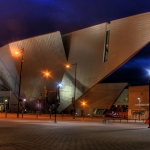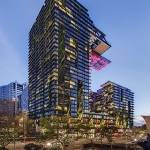News
Cladding: A permanent first impression
They say you can’t judge a book by its cover, that it’s what’s on the inside that counts. But be honest: When you arrive in a new city and lay your eyes upon its modern skyline for the first time, what are you really thinking about? The brilliant glass and steel curtain walls that reflect the early morning sunlight or the internal beams and columns that hold everything up?
Okay, some of us structural engineering types might actually be thinking about the framework, we freely admit. But most of us will almost certainly notice the cladding. Cladding is a critical part of what defines an iconic building. It’s what makes a structure instantly recognizable.
Consider the Denver Art Museum’s Hamilton Building, designed by architect Daniel Liebeskind. The building’s striking angular features draw the eye skyward, while the 9,000 titanium panels echo the more than one million pyramidal glass tiles that adorn Giò Ponti’s adjacent castle-like North Building. One forms an impression that these formidable buildings are there to protect the art within, that the Colorado wind and snow stop at their impenetrable walls.
Contrast this with Sydney’s One Central Park, named the world’s best tall building for 2014 by the Council on Tall Buildings and Urban Habitat. One Central Park’s two residential towers feature 250 species of native flowers and plants that weave together with traditional cladding elements. The soft vegetation on glass and steel suggests Cambodia’s Ta Prohm or Mỹ Sơn in Vietnam, where the natural world has reclaimed formerly occupied spaces. But here, nature is an invited guest, not an opportunistic squatter.

 The point is that cladding creates a lasting impression and identifies a structure as unique in the minds of occupants, visitors, and passersby. It’s a permanent first impression. Today’s visitors to Boston are likely to find the John Hancock Tower’s monolithic glass façade impressive and elegant, but those who were present for its commissioning may forever remember it as the Plywood Palace (a nickname given when, due to engineering problems, plywood sheets temporarily replaced many of the tower’s glass windows).
The point is that cladding creates a lasting impression and identifies a structure as unique in the minds of occupants, visitors, and passersby. It’s a permanent first impression. Today’s visitors to Boston are likely to find the John Hancock Tower’s monolithic glass façade impressive and elegant, but those who were present for its commissioning may forever remember it as the Plywood Palace (a nickname given when, due to engineering problems, plywood sheets temporarily replaced many of the tower’s glass windows).
Cladding doesn’t just keep the weather out: It projects an identity. Well-designed cladding is a critical piece of a building’s individuality, as much an occupant as the people who live and work inside. So it pays to get it right the first time. After all, a timeless design can only remain timeless if it stays put.
